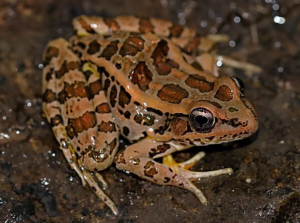Become a Donor

In the partial light of dawn, my younger self is poking around in a deep erosion rut cutting through the valley bottom of the farm we just bought. I was finding lots of sand, chunks of sandstone and limestone, and occasional pieces of iron ore. Just as the sun’s first rays break the ridgetop, I see it. I grab a handful of the damp earth, squeeze it in my hand, forming a compact ball of soil. She’s going to love me!
I rush back to our campsite to show my wife. “Debra, wake up, you have to see this!” She doesn’t stir. “It’s important, you’re going to love it.” Her sleep-weary face peeks out from under her sleeping bag hood. “Can’t this wait until after sunrise?” she protests. I show her the ball of soil. Her face contorts in a look of confusion. “It’s clay,” I say. Her expression doesn’t change. “It means we can have a pond,” I clarify. Her eyes open wide.
My wife, a child of Lake Michigan, is never far from open water in her thoughts. Her dream for our newly acquired land was to have a pond. A place of open water to enjoy.
A shallow water, fishless pond became reality, and with it came a plethora of wildlife.
It wasn’t long after the installation of the pond that we discovered a pickerel frog, an at-risk species in Wisconsin. Fast forward a few years, once the deep roots of native prairie and savanna vegetation again cover the previously eroded soils, amphibian populations, including the pickerel frog, exploded.
The deep-rooted plants allowed water to recharge the original soil hydrology, and cold-water springs emerged in a couple of locations. We had all the ingredients necessary now to sustain the complex habitat requirements of the pickerel frog.
The pickerel frog has a lot of needs. It needs permanent, or semi-permanent warm water (ideally fishless) to reproduce. Adult frogs will seek out these shallow warm-water areas in the spring and often call underwater. Their breeding call is rather soft, infrequent and sounds like someone snoring. They tend to pick areas with a lot of emergent vegetation present (such as lake sedge) to give them cover from predators. The water needs to hang on (not dry up) into late summer to ensure the tadpoles have enough time to metamorphose into frogs.
In order to survive the winter, pickerel frogs require pools of spring-fed water or clean water that is resistant to freezing. They will enter these areas in the fall and hang out on the bottom until spring arrives.
Between the times of mating season and winter hibernation, pickerel frogs require extensive grasslands for foraging and protection. The best grasslands are a continuum of wet habitat such as sedge meadows that transition all the way up into the uplands including oak savanna and open-oak woodland. Strong jumpers, adult pickerel frogs spend most of their active lives well away from water.
During the drought of 2012, I was surprised by all the frog activity I witnessed in our oak savannas. With most of the wetlands dried up, perhaps they found the filtered sunlight of the oak savanna a relief from the intense sun’s heat in the open grassland areas.
Grasslands, savannas and open-oak woodlands are best maintained with fire to ensure they don’t transition into closed-canopy woodland communities. When implementing prescribed fire, there are a few precautions needed to minimize frog causalities.
Burn when ice is still present in open-water areas and frost still in the soil. Frogs will be in hibernation and not susceptible to fire. Rotational burning, or alternating burn areas from year to year, will ensure there will be areas of cover present when frogs emerge from hibernation.
When the above habitat requirements are in place, and the grassland communities maintained with the careful use of fire, pickerel frog populations will explode. Most years, in late July, paths through our wetlands are covered with hundreds of wildly jumping newly-arrived pickerel frogs.
To my knowledge, our pickerel frog population is an isolated one, and I worry about its long-term survival. Our “donor” frogs, the ones that started the healthy populations we have today, came from a neighboring wetland that is no longer present.
Now, our land is the donor population, sending out hundreds of hopeful young frogs every year as they seek to establish new territories. I think about these little guys, venturing out into inhospitable lands, simply following their genetic code that had served them so well in the past.
Life is fragile but also resilient. The landscape is not static, perpetually influenced by the decisions of its human landlords. We can make the ecosystem strong or weak based on our choices. Consider this hypothetical scenario.
Two miles down the valley, a daughter takes over the family farm. With broader farm goals than her parents, she decides to take advantage of some Farm Service Agency (FSA) conservation programs. She installs native vegetation buffer strips along the eroded creek and converts the troublesome muck bottom back to a wetland. Stable income and a place for younger generations to play, learn and discover nature, she reasons.
The following fall, several travel-worn pickerel frogs slip into the newly created, earth-warmed waters now bubbling to the surface rather than diverting underground by a tile system to the nearby drainage ditch. Here they will spend the winter, bathed in waters resistant to winter’s iciest grip.
Come April or May, in shallow pools isolated from the cool-water springs and warmed by the sun, the breeding-call snore of the pickerel frog will once again be heard in these lands.
Originally published in Environmental Returns.


